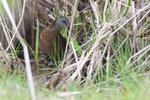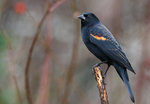

This past weekend I realized something – no matter where I go, there are birds sharing my world with me. What a joy I felt! We walked on the Chehalis Western Trail, just north of Shincke Road. The trail passes between two ponds, aka wetlands, marshes, or swamps, all of which are the same when providing key habitat for some of our more interesting Thurston County birds.
And here, right by the trail and over the entire area, were Red-Winged Blackbird males singing their hearts out. From late winter until late summer, the male repeats his familiar territorial call, which I like to write out as “pa-pa-geeeee-no.” Makes me think of the bird catcher, Papagano, in the Mozart opera The Magic Flute.
The males of this species are all black except for their bright red and yellow wing patches, which they like to flash when singing and doing territorial displays. The females (and young of the year) look totally different from males, with a streaked brown body and no bold color markings. In wetlands with floating lily pads and the like, these birds are often seen walking on the pads seeking out food – they’re omnivorous, eating plant material, seeds, insects, and the like.
And then, not to be outdone by the blackbirds, there was a small flock of Cedar Waxwings. These birds are not usually described as wetlands birds, but they are common near wetlands and along rivers at this time of year. They are nesting, and the flying insects that occur over water are an important source of food for their young. These are stunningly beautiful birds, with feathers so smooth, they look like they’ve been waxed. They have a neat small crest, red wing bars and a bold yellow stripe across the tip of the tail. They have a high-pitched “tsee, tsee” call, which might be your first clue that they’re nearby. They are not shy, so you are likely to get a good look at them when they are nearby.
And then, at the Billy Frank, Jr. Nisqually National Wildlife Refuge ...
Another wetland I like to visit is the central marsh at the Billy Frank, Jr. Nisqually National Wildlife Refuge. The short boardwalk trail takes you right out along the water and vegetation. And it’s there, almost every visit no matter the season, that I hear, and sometimes see, the Marsh Wren. These birds are not conspicuous; in fact, they’re downright secretive. But they give themselves away with their characteristic song, a buzzy trill, issuing from the cattails or other vegetation. Almost any wetland that has cattails will have Marsh Wrens.
Wrens in general are cavity nesters, but there are no cavities in a wetland. Marsh Wrens solve the problem by weaving their own “cavity” out of dry reeds. You can sometimes see old nests the following winter as vegetation dies back.
These are small birds and, like other wrens, both sexes look alike. They have a longish, curved bill. At a glance they will look brown, with a buffy breast and eyebrow. But in good light you might notice small white streaks on their backs.
The description “inconspicuous” really fits two other wetland bird species, Virginia Rail and Sora.
Rails are seldom seen; they are very shy and secretive and best identified by their call. The Virginia Rail’s call is a repetitive “ka dick, ka dick,” and the Sora’s is a squealing, descending whinny. These birds are sometimes seen along the edge of wetland vegetation; they are brownish with the Virginia having a fairly long drooping bill and the Sora having a short, stubby bill.
Here’s something to try at a wetland – loudly call out “ka dick, ka dick” several times. There’s a good possibility that you’ll get a response from that shy, but fairly common, Virginia Rail.
Our county is fortunate to have many quality wetlands available to public access. These habitats are great for bird watching and, because the mix of birds varies with the change of seasons, they are worth revisiting regularly.
George Walter is the environmental program manager at the Nisqually Indian Tribe’s natural resources department; he also has a 40+ year interest in bird watching. He may be reached at george@theJOLTnews.com
Photos for this column are provided by Liam Hutcheson, a 14-year-old Olympia area birder and avid photographer.
Comments
No comments on this item Please log in to comment by clicking here